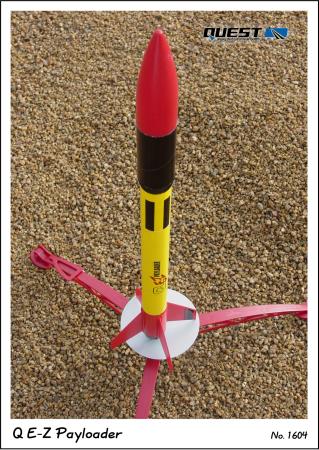| Construction Rating: | starstarstarstar_borderstar_border |
| Flight Rating: | starstarstar_borderstar_borderstar_border |
| Overall Rating: | starstarstarstar_borderstar_border |

Brief:
A three finned 18mm rocket that has a quick assembly of the fin unit, has a
payload area, and recovers via two 12 inch parachutes. I bought mine in a job
lot from a shop that closed down a few years ago. I probably would not have
bothered building it, but it was on the EMRR Hit List...
Construction:
Kit consists of:
- motor clip
- blue thrust ring
- yellow motor mount tube
- blue centering ring
- yellow body tube
- black payload tube
- upper and lower plastic fin ring
- 3 plastic fins
- 2 plastic launch lugs
- large plastic reducer
- plastic tube coupler
- plastic nose cone
- 24inch elastic shock cord
- 21 inch Kevlar® shock cord
- 2 12 inch parachutes
- 2 packs of 26 inch shroud lines
- 12 gripper tabs
- Decals
To build the kit I used:
- white glue
- model knife
- sandpaper
- plastic glue
The instructions are very clear, and this rocket builds in minutes plus glue drying time. The snap together fin system is a new one on me, but it is easy to build and that is what Quest was going for. It sure is ugly though. Why they did not go for a plastic fin can? I don't know.
The tubes are pre-colored, however, there are noticeable spiral groves on all of them. The plastic couplers, transitions, etc. don't fit the body tubes so great either, although there are shoulder shims included to overcome this.
The only downfall in the design is the small shoulder on the transition. At only 6mm, the top payloader section is not securely fixed in place even with the shims added. I have doubt whether the two sections would stay together in flight if there was a heavy payload was in the top section. I would also have liked to see a clear payload body tube so you can see the payload, but I'm being a bit picky here. If you want access to the payload bay, then the nose cone should not be glued on. I was concerned that the coupler and the transition were both hollow, so the ejection charge could pressurize both the body tube and the payload area. To be on the safe side, I filled the small hole in the transition. This isn't really necessary as the parachute/wadding fill the gap on ejection.
If you've flown Quest rockets before, then you know to ditch the stiff parachutes for anything else. I swapped mine for Estes bin bag chutes.
For a first flight I don't normally change much it the rocket design, but I really doubted the 2 parachute recovery. This is not a heavy rocket without the payload, and with two twelve inch parachutes, one on each section, I can imagine a long drift. So I tied both sections together, added a swivel to the top of the shock cord, and used an 18 inch Estes chute with a spill hole cut out. The chute was attached to shock cord swivel via a snap swivel. I also added an anti-zipper cloth tape to the Kevlar® where it would meet the shoulder of the body tube.
Finishing:
You just add the two decals provided. These are the peel and stick type and go
on easily.
Construction Rating: 3 out of 5
Flight and Recovery:
It flies on B6-4, B6-2, C6-3, C6-5, but the longer delays are needed for when
there isn't a payload. I used Nomex®
wadding. The first (and possibly last) flight was nice and straight. It came
off the pad at a good speed. During the boost phase, the payload section
separated before ejection. At ejection the parachute failed to deploy. The
whole lot came in ballistic. The body tube was smashed. It will be possible to
repair, but I currently have several more pressing projects. The small shoulder
on the payload section was partially to blame, however, the failure of
deployment was the main reason and I'll take the blame for poor packing of the
Nomex®
wadding.
Flight Rating: 2 out of 5
Summary:
This is a good rocket for those that want to move up from RTFs but don't want
to get into gluing fins on. As a payloader, there are better choices on the
market, but for the younger rocketeer, then it's a step up from an basic 3FNC
rocket. I personally would not recommend this kit to anyone.
Overall Rating: 3 out of 5
 |
 |
Flights
 |
 |
